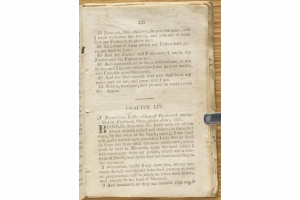Historical Context and Background of D&C 54
Brief Synopsis by Steven C. Harper
Newel Knight led the New York Saints to Thompson, Ohio, where they settled on Leman Copley’s land and “commenced work in all good faith thinking to obtain a living by the sweat of the brow.”1 Then section 51 instructed Bishop Partridge to obtain a deed from Leman for the land “if he harden not his heart.”2 But after obeying section 49’s command to preach the gospel to members of the United Society of Believers in Christ’s Second Appearing, Leman forsook his faith in the restored gospel and returned to that Society.3 Then he ordered the Saints off his land.
Joseph Knight said they “had to leave his farm and pay sixty dollars damage for putting up his houses and planting his ground.”4 Where should they go and what should they do to provide for themselves? Joseph’s history says that the Saints in Thompson, “not knowing what to do, sent in their elders for me to inquire of the Lord for them.” He did and the Lord answered with section 54.5
The eternal Lord Jesus Christ who was crucified for the sins of mankind spoke to Newel Knight, presiding elder of the Saints in Thompson: “You must stand fast in the office whereunto I have appointed you,” the Savior said. The Lord makes repentance and humility the conditions on which the Saints in Thompson will escape their enemies. Because Leman Copley broke his covenant to consecrate land, the covenant is null and void. The Lord blesses the Saints who have kept the covenant. He commands them to flee from their enemies by traveling to Missouri as a group, appointing a treasurer to pay fares and tolls along the way.
Western Missouri bordered on the territory recently set apart by the U.S. government for Native Americans to settle. The Lord commands the Saints to find ways to make a living after they arrive until Zion can be established and land provided for them to inhabit. He commands them to patiently endure hardships until the Lord’s coming. He will reward those who seek him. The souls of these early converts will rest with the Lord.
As a result of section 54, the saints from Colesville, New York, continued their group trek all the way to Missouri. Led ably by Newel Knight, they became the nucleus of the Church in Jackson County and gave their lives to building Zion.
1. Newel Knight Autobiography, 30.
2. “Revelation, 20 May 1831 [D&C 51],” p. 86, The Joseph Smith Papers, accessed July 30, 2020.
3. Dean C. Jessee, editor, “Joseph Knight’s Recollection of Early Mormon History,” BYU Studies 17:1 (1976): 29–39.
4. Joseph Knight, Jr., Incidents of History 1827–1844, Church History Library, Salt Lake City.
5. “History, 1838–1856, volume A-1 [23 December 1805–30 August 1834],” p. 121, The Joseph Smith Papers, accessed July 30, 2020; “John Whitmer, History, 1831–circa 1847,” p. 29, The Joseph Smith Papers, accessed July 30, 2020.
Additional Context, by Casey Paul Griffiths
From Doctrine and Covenants Minute
When Joseph Smith had first arrived in Kirtland in February 1831, one of the most welcoming of the new converts had been Leman Copley. Copley had offered for Joseph and Sidney Rigdon to live with him in Thompson, Ohio, and had even offered them housing and provisions. Joseph and Sidney found other living arrangements, but, encouraged by Copley’s generosity, Joseph made plans for the emigrating members of the Colesville Branch to settle on Copley’s property.
While the Colesville Saints were traveling to Kirtland, Leman Copley was called to accompany Sidney Rigdon and Parley P. Pratt on a mission to members of his former faith, the Shakers. Unfortunately, the mission to the Shakers failed to convert anyone, and Copley’s faith was shaken. He soon returned to the Shaker community and reconciled with them. Afterward, he returned to his home with Shaker leader Ashbel Kitchell, apparently with the intent to evict any Church members on his property. When Kitchell arrived on Copley’s farm, members of the Colesville Branch were already there. Kitchell became involved in a discussion with Newel Knight, the leader of the Colesville Branch, that elevated into a shouting match with Joseph Knight Sr. (Lawrence R. Flake, “A Shaker View of a Mormon Mission, BYU Studies, 20, no. 1, 1979, 4).
Following the altercation, the members of the Colesville Branch were forced to leave Copley’s land. Joseph Knight Jr. later recalled bitterly, “We had to leave his [Copley’s] farm and pay sixty dollars damage . . . for fitting up his houses and planting his ground” (Joseph Knight Jr. Autobiographical Sketch, 2–3). With no place to go, the evicted Saints approached Joseph Smith for direction and guidance. Newel K. Whitney later recalled, “We commenced work in all good faith, thinking to obtain a living by the sweat of the brow. We had not lingered long before the above-named Copley broke the engagement which he made with us. At this time, I went to Kirtland to see Brother Joseph” (Rise of the Latter-day Saints, 33–34).
See “Historical Introduction,” Revelation, 10 June 1831 [D&C 54].

